Introduction
In 1943, neurophysiologist Warren McCulloch and logician Walter Pitts published "A Logical Calculus of the Ideas Immanent in Nervous Activity" in the Bulletin of Mathematical Biophysics. This paper introduced the world's first mathematical model of artificial neurons, laying the foundation for everything from modern neural networks to today's deep learning systems that power our favourite AI applications.
"Simple mathematical neurons connected in networks can unlock the computational power hidden within biological intelligence."
Core Ideas
The paper's central insight was revolutionary yet elegant. McCulloch and Pitts recognised that because of the "all-or-none" character of nervous activity, neural events and their relationships could be treated using propositional logic. Think of biological neurons as simple switches - they either fire (output 1) or don't fire (output 0), much like the binary logic we use in programming.
Their artificial neuron model, later known as McCulloch-Pitts neurons, receives inputs, performs a weighted sum, and fires an output signal based on a threshold function. The mathematical formulation was straightforward: if the sum of weighted inputs exceeds a predetermined threshold value, the neuron fires; otherwise, it remains inactive.
The model operated under specific assumptions that simplified the complexity of biological neurons. For a neuron to fire, the weighted sum of inputs had to equal or exceed a predefined threshold. If one or more inputs were inhibitory, the neuron would not fire. It took a fixed one time step for signals to pass through a link, and neither the structure nor weights changed over time.
What made their work truly significant was the demonstration that by connecting these units in various configurations, their model could perform all logical functions. They showed that networks of these simple artificial neurons could implement fundamental Boolean operations like AND, OR, and NOT gates.
Breaking Down the Key Concepts
To understand their breakthrough, consider how we might program a simple decision-making system today. Instead of writing complex if-else statements, McCulloch and Pitts proposed that we could use networks of simple threshold units that naturally compute logical operations.
Their neuron model works like a weighted voting system. Each input has a weight (importance), and if the total "votes" exceed the threshold, the neuron "decides" to fire. For instance, if a bird needs to decide whether to eat something, it might have inputs for "roundness" and "purple colour." With appropriate weights and threshold, the bird would only eat when both properties are present (like blueberries) but not when only one is present (like golf balls or violets).
The genius lay in the mathematical abstraction. McCulloch and Pitts showed that given the all-or-none character of neural activity, the behaviour of the nervous system could be described using propositional logic. This bridged the gap between biological intelligence and mathematical computation, providing a framework that engineers could actually implement.

Results and Significance
The paper's most profound contribution was proving that neural networks could perform any logical computation. This meant that, in principle, networks of their simple artificial neurons could solve any problem that could be expressed in logical terms. They demonstrated that any Boolean function could be implemented by networks of such devices, which was easily seen from the fact that one could implement AND and OR functions.
For developers working in today's AI landscape, this is the foundation upon which everything else builds. The principles laid out by McCulloch and Pitts became the foundation for more complex networks, eventually leading to the development of deep learning. Every neural network library you use - from TensorFlow to PyTorch - traces its conceptual roots back to these threshold logic units.
Their paper presented the highly original hypothesis that human mental abilities, especially our capacity for logical thought, stem directly from neuronal circuits in the brain that themselves perform logical operations. This was the first computational theory of mind rooted in the biophysical substrates of the brain.
The work directly influenced computer science development. McCulloch and Pitts's contributions included a formalism whose refinement led to finite automata, a technique that inspired logic design (fundamental to modern computer design), the first use of computation to address the mind-body problem, and the first modern computational theory of mind and brain.
Read the full paper here - https://link.springer.com/article/10.1007/BF02478259